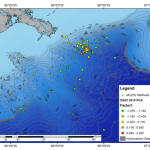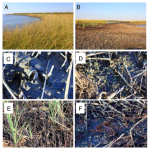![]() Everything we do in life presents choices, and every choice presents a risk. Some activities present a high and obvious risk, like skiing a black diamond without a helmet. The inherent risks in more mundane activities may be well-documented, yet so subtle, that we choose to ignore them on a day-to-day basis…like eating seafood.
Everything we do in life presents choices, and every choice presents a risk. Some activities present a high and obvious risk, like skiing a black diamond without a helmet. The inherent risks in more mundane activities may be well-documented, yet so subtle, that we choose to ignore them on a day-to-day basis…like eating seafood.
This week, the controversy over Gulf seafood continued to escalate. More people have questions and more people want answers—meanwhile, on the other end of the spectrum the PR campaign continues with staged “stuff your face with po’-boys” photo-ops and ringing declarations all seafood on the market is 100% safe.
Seafood safety is an important issue, and there is a LOT that I want to cover in this series (it may even go up to 10 parts, judging from the length of my notes)–but for now, I present you with part 1:
How do we measure seafood contamination?
The primary criteria for assessing seafood safety are polycyclic aromatic hydrocarbons, our old friends that you may remember from the dispersant series. Low-molecular weight PAHs (naphthalene, fluorene, dibenzothiophene, anthracene and their substituted homologues) are pretty nasty compounds; highly soluble in water, highly toxic, and break down slowly—detecting these compounds in the water is typically used to assess potential seafood contamination. Interestingly, the NOAA publication “Managing Seafood Safety after an Oil Spill” notes that:
There are no established limits for PAH exposure to assure food safety, but from prior experience with other oil spills, guidelines have been calculated for consideration. These guidelines account for both the amount and duration of exposure, and they vary by type of seafood. The guidelines are based on highly sensitive analytical detection of contaminants at concentration levels as low as parts per billion (ppb; one part contaminant per one billion parts of edible seafood).
Your potential level of exposure to PAHs is highly dependent on what you’re eating: pelagic fish can quickly and efficiently eliminate these compounds from their bodies, while this capacity is reduced in crustaceans and highly limited in shellfish. People also tend to eat whole invertebrates (=eating all PAHs in present in its body) versus only the muscle tissue of fish (=avoiding the fish liver where the PAHs would be concentrated, if present).
Within each group of animals, metabolism of PAHs can vary by life history and reproductive stage. Burrowing lobsters affected by the Braer spill (off the Shetland Islands in 1993) retained contaminants up to five years post-spill, versus lobster species living atop the sediment which could metabolically expel PAHs after only one month (Kingston 1999). Sessile, immobile mollusk species also cannot move away from contaminated areas, and thus have been observed to have long-term PAH exposure patterns in persistently oiled sediments (Law et al. 1997). The shoreline effects of the BP spill certainly seem to mirror such a scenario, with continued sightings of tarballs, and seemingly ample evidence for subtidal tar mats which can lead to persistent coastal re-oiling.

Marine organisms can uptake PAHs in a number of ways (NOAA report):
• Finfish and crustaceans are predatory or omnivorous. They are exposed to oil by ingesting con- taminated food items or sediments, and by absorbing water-soluble petroleum compounds through the gills.
• Filter feeding bivalves may ingest dispersed oil droplets and absorb water- and lipid-soluble petroleum compounds as they filter plankton and detritus suspended in the water column.
• Deposit-feeding bivalves may be exposed to oil through contaminated sediments as they feed on benthic detritus, and as they absorb water-soluble compounds from the interstitial water in sediments.
Species with higher overall lipid content in their bodies are more likely to accumulate PAHs—e.g. fattier finfish such as salmon, or oysters/clams at the peak of the spawning season where lipid-rich eggs are being produced. Given these natural temporal shifts, a Gulf species that currently falls under the ‘safe’ threshold for PAHs could be lablled unsafe in the future.
Perhaps most notably, organisms chronically exposed to oil contamination become less able to expel harmful compounds from their tissues in the long-term. From the NOAA report (refer PDF for references):
Some chronic hydrocarbon pollution studies have indicated no significant reductions in PAH levels in tissues over 2-4 months for clams and mussels, even when the animals were moved to cleaner habitats (DiSalvo et al. 1975; Boehm and Quinn 1977).
Now, even if you don’t eat seafood you are probably ingesting these PAHs. Do you like blackened jerk chicken off the grill in the summer? Yep, you’re eating plenty of carcinogenic PAHs from that charred goodness. Do you like growing fresh spinach from your rooftop city garden (air deposition from smog)? Love that artisanal slow-smoked salmon (generated during smoking process)? Ditto to both.
Yet, no one would tell you that spinach or smoked salmon was unhealthy. The more you know about your food, the better you can assess the risk. FDA tests currently state that the level of PAHs detected in their tests do not pose a human health risk–we’ll explore what those tests actually mean in the next part. Right now, what’s worth more–eating that delectable shrimp gumbo and reveling in your sated appetite, or foregoing Gulf seafood and gaining the peace of mind that you may be minutely decreasing your long-term cancer risk? There is no right or wrong answer—just different choices.
References:
Yader, R., Michel, J., & Lord, C. (2002). Managing Seafood Safety after an Oil Spill Seattle: Hazardous Materials Response Division, Office of Response and Restoration, National Oceanic and Atmospheric Administration.http://response.restoration.noaa.gov/book_shelf/963_seafood2.pdf
Kingston, P. 1999. (1999). Recovery of the marine environment following the Braer spill, Shetland Proceed- ings 1999 Oil Spill Conference, Seattle, Washington, March 8-11, 103-109
Law, R., & Hellou, J. (1999). Contamination of Fish and Shellfish Following Oil Spill Incidents Environmental Geosciences, 6 (2), 90-98 DOI: 10.1046/j.1526-0984.1999.08039.x






2 Replies to “Sunday Spill Special: Seafood Safety, Part 1”
Comments are closed.